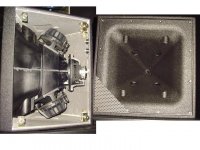Had a idea that it should be possible to do an MEH with a co-axial woofer.
Sort of a cross between a Tannoy co-axial and an MEH.
The horn portion of the MEH would pass thru the woofer, and the woofer would be connected to the horn via short holes/slots, rather than use the woofer cone as the horn, as the Tannoy does.
This should make it possible to make the interface between the woofer and the horn into a proper phase assembly, just like a scaled-up compression driver.
Better phase coherence should provide a lot more flexibility.
Obviously this requires a woofer with a hole thru the centre, MacCauly do one, for their own modular coaxial speakers.
Anyone tried this?
Or have any recommendations for woofers?
David
Sort of a cross between a Tannoy co-axial and an MEH.
The horn portion of the MEH would pass thru the woofer, and the woofer would be connected to the horn via short holes/slots, rather than use the woofer cone as the horn, as the Tannoy does.
This should make it possible to make the interface between the woofer and the horn into a proper phase assembly, just like a scaled-up compression driver.
Better phase coherence should provide a lot more flexibility.
Obviously this requires a woofer with a hole thru the centre, MacCauly do one, for their own modular coaxial speakers.
Anyone tried this?
Or have any recommendations for woofers?
David
Hmmm. You'd want to make sure the horn and cone are close so the ports are short. This might mean finding a cone of suitable shape.
The DSL SM-60F is one example, using two 8” woofers for low frequencies, mid-high covered by a 5” coaxial driver.
The DSL SM-60F is one example of a MEH using two 8” woofers for low frequencies, mid-high covered by a 5” coaxial driver.I thought Danley sound labs had already done this ? SM range possibly ?
@Patrick Bateman shows a potential coaxial unity horn design here: https://www.diyaudio.com/community/...ay-unity-waveguide.342019/page-3#post-5928419
A bit more discussion here, where I found that link: https://www.diyaudio.com/community/threads/synergy-horn-with-coaxial-speaker-unit.343231/
A bit more discussion here, where I found that link: https://www.diyaudio.com/community/threads/synergy-horn-with-coaxial-speaker-unit.343231/
Does the 5" coaxial driver actually have multi-entry holes so the lower frequencies are fed in further up the horn, as is the Unity patent?The DSL SM-60F is one example...covered by a 5” coaxial driver.
Or is it just a coax driver at the base of the horn?
I believed it was the later but I can't find a definitive cross section or exploded picture.
Hmmm. You'd want to make sure the horn and cone are close so the ports are short...
Yes, in a quick sketch it looks OK but it deserves some CAD.
Just wanted to see if anyone had tried this before I spent the time.
Should have expected @Patrick Bateman 😉
It should be possible to control the port feed-in locations and distances so the input stays in phase as the wave-front travels up the horn, sequentially past each circle of ports.
Did that make sense or do I need a picture?
Best wishes
David
Does the 5" coaxial driver actually have multi-entry holes so the lower frequencies are fed in further up the horn, as is the Unity patent?
There use to be a cutaway rendering if I'm remembering the right model, but didn't save it and couldn't find it in a quick search, though it did have vents out near the edges of the mid woofer that weren't obvious to me at first glance till I blew it up a bit; quite a 'slick' design I thought at the time, but appeared to be too much hassle to DIY, so basically forgot about till now.
David,Does the 5" coaxial driver actually have multi-entry holes so the lower frequencies are fed in further up the horn, as is the Unity patent?
Or is it just a coax driver at the base of the horn?
Unlike the SH100 or SM80 Synergy horns that use coax with the cone as the beginning of a larger round horn, the DSL SM-60F uses separate injection ports for the cone entry points.
Photos in Craig Leerman's road test show the 9 entry holes in the DSL SM-60F:
https://www.prosoundweb.com/road-test-danley-sound-labs-sm-60f-th-mini/2/
The DSL SM-60F 5" coaxial driver cone feeds through 4 round port holes surrounding the HF entry.
Each 8" has two injection port holes, followed by bass reflex ports, Fb around 64 Hz as can be seen by it's impedance chart.
My guess is the SM-60F uses the BMS 5CN140 coax, or a driver that looks very similar.
Art
I've definitely read posts from Ivan Beaver talking about moulding / casting the horns for this over on Prosoundweb...
Rob.
Rob.
Some quick pics to give an idea.
I'm using a Vifa ne265 with the aurasound whisper driver as a mid/tweet.
Rough 3d printed waveguide to see how it all fits and to measure a few different profiles and hole placement. I may even just let the output of the woofer exit from the sides opening between the woofer frame and rear of the waveguide, time will tell
The eventual plan is to load the whole thing in a cardioid enclosure and cross at around 200hz to twin woofers. Last pic is a comparison of the Dayton 10" waveguides to my profile.





I'm using a Vifa ne265 with the aurasound whisper driver as a mid/tweet.
Rough 3d printed waveguide to see how it all fits and to measure a few different profiles and hole placement. I may even just let the output of the woofer exit from the sides opening between the woofer frame and rear of the waveguide, time will tell
The eventual plan is to load the whole thing in a cardioid enclosure and cross at around 200hz to twin woofers. Last pic is a comparison of the Dayton 10" waveguides to my profile.
- Home
- Loudspeakers
- Multi-Way
- Multi Entry Horn (MEH) with Coaxial _Woofer_?
